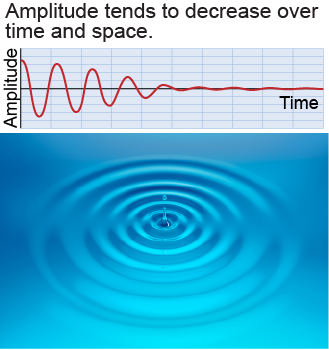|
Waves are a form of moving energy. Waves may move through matter, but a wave is not matter itself. For example, a water wave is not the water, which exists independently of the wave. A water wave is a form of pure energy. When a water wave moves across a pond surface, the wave’s energy causes the matter to respond—by moving up and down. Once the wave passes, the matter returns to equilibrium again. Waves transfer energy from one location to another. 
|
The energy of a wave increases with frequency. The three waves in the diagram below have the same amplitude and different frequencies. The wave with the higher frequency transfers more energy. This is true for almost all waves, including water waves, sound, and light. 
|

|
The energy of a wave also increases with amplitude. If two waves have the same frequency, the wave with the larger amplitude transfers more energy. With water waves, larger amplitude means that the wave lifts the water a greater distance above its equilibrium level. With sound waves, larger amplitude means louder sound. With light waves, larger amplitude means brighter light. 
|

|
 As a wave spreads out, its amplitude decreases. This can happen for two reasons. One is damping, a process in which friction reduces the wave energy over time. But there is also a second reason that amplitude decreases. As a wave propagates, its energy may spread out over a larger area. That leaves less energy in any given portion of the wave. This is the main reason why ripples get smaller and smaller as they spread. It is also the reason why light gets dimmer as you get far from a bulb and sound gets fainter far from its source.
As a wave spreads out, its amplitude decreases. This can happen for two reasons. One is damping, a process in which friction reduces the wave energy over time. But there is also a second reason that amplitude decreases. As a wave propagates, its energy may spread out over a larger area. That leaves less energy in any given portion of the wave. This is the main reason why ripples get smaller and smaller as they spread. It is also the reason why light gets dimmer as you get far from a bulb and sound gets fainter far from its source. 
|
Although speech gets quieter farther from its source, the words and tone are still the same. Why is this?
 |
Over time and distance, air resistance reduces the amplitude of a wave by damping. The frequency of a wave remains constant, however, so it still transfers the same information even if it has less energy. 
|
| |
|

